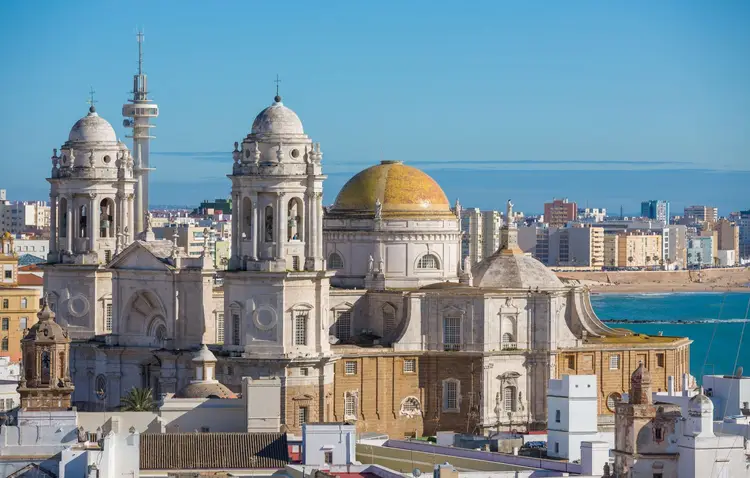The feature for this month’s issue of Europe Uncovered was written up by my colleague Sophia Titley, our real estate editor, who spent some time scouting in a corner of Spain that I haven’t yet been to, but is now very much on my radar…
It’s called the Costa de la Luz, or the Coast of Light, and going from northwest to southeast, it stretches from Spain’s border with Portugal down to Tarifa, the southernmost point in Europe, almost touching Morocco across the Strait of Gibraltar, along the Atlantic Coast.
Here is Sophia’s take on the region.
This region is famous for the very thing it’s named for: dazzling, always abundant sunshine. At well over 3,000 sunshine hours per year, vitamin D deficiency is not a risk here.
Start Your New Life Overseas Today!
Sign up for our free daily e-letter, Overseas Opportunity Letter, and we’ll send you a FREE report on the 10 Best Places To Retire In 2025.
We Value Your Privacy! We will not share your email address with anyone else, period.
The Costa de la Luz’s centerpiece is Cádiz. It’s often called “Little Havana” or compared to Old San Juan, Puerto Rico, because of its long board-walked beachfront backed by colorful ancient buildings…
But Cádiz is the prototype that those New World cities were based on. It’s often touted as the oldest city in Western Europe, dating to 1104 BC.
Walking its streets, you can feel the history and see the cultural influence of the many civilizations—from Phoenicians to the Romans to the Moors—that impacted it over time.
Its Old Town is densely populated, with one of Europe’s oldest neighborhoods and ruins hemmed in by old city walls. Individual landmarks syncretize various architectural styles. Narrow streets spill out into lively plazas where you can sit in the shade of a towering cathedral and watch the world go by…
But there’s more to the Costa de la Luz than just Cádiz…
Cádiz Province (one of the two provinces that the Costa de la Luz covers; the other is Huelva) offers everything from well-appointed beachfront towns to ancient hilltop villages that can be seen for miles because of their brilliant white-washed buildings.
Across these towns, you find pockets of expats that love the region for its low cost of living, beautiful beaches and pristine nature, and authentic culture.
The Costa de la Luz is not the most popular destination in Spain for expats… but its authenticity and low-key local vibe is part of its appeal. That said, in certain towns around the region, you’ll find some decent-sized expat communities that you can join, if you want to…
Cádiz, despite being the biggest city on this coast, is not home to a huge number of expats. I’d estimate that no more than a dozen or so call the Old Town home, and some of them are only here on a seasonal basis.
About 28 miles north of Cádiz, however, is Rota, the town that’s famous for the Rota naval base, which is shared by Spanish and U.S. forces. It hosts U.S. Marine Corps and U.S. Air Force units, so there is a big American presence in this town of 29,000.
I was pleasantly surprised by how well-connected the Costa de la Luz is. I rented a car while I was there, and the roads are in excellent condition: smooth paving, clear lines, well-lit, and well-signposted. I’m not a confident driver, but I’d feel comfortable driving around here.
That said, you might not need a car. Town centers, especially Cádiz, are compact. Keep in mind that many of the towns in the region are ancient, developed centuries before the concept of a car came to be. They were intended to be navigated on foot and that continues to be the best way to navigate them.
One of the biggest reasons to choose Spain as your overseas retirement destination is that it’s fantastically affordable.
Many Americans and Canadians have this perception of Western Europe as being financially out of reach, a destination only accessible in daydreams…
The truth is that many Western European countries—especially Spain and especially the Costa de la Luz—are more affordable than the States or Canada. That’s a lower cost of living for a higher quality of life, too.
Why This Coast?
The Costa de la Luz stands out for the diversity of lifestyle options it offers. You can base yourself in a city environment, like Cádiz or even Sevilla (although it’s not technically on the coast) or in one of the surrounding small towns.
It’s easy to navigate around the region, so you can get the best of all lifestyles regardless of where you settle.
Start Your New Life Overseas Today!
Sign up for our free daily e-letter, Overseas Opportunity Letter, and we’ll send you a FREE report on the 10 Best Places To Retire In 2025.
We Value Your Privacy! We will not share your email address with anyone else, period.
The region lives up to its name: The Coast of Light. The sunny, warm weather pairs nicely with the long stretches of golden sand beach that you find in most towns. Nature is pristine here.
Plus, it’s safe. You’ll see everyone from little kids playing in the town plaza to groups of elderly women socializing until late into the evening… like until 11 p.m. or even past midnight.
Unlike the Costa del Sol next door, the Costa de la Luz is authentic. Sure, it receives some tourism and has an expat community, but it’s nothing compared to the resort and British retirement-towns that dominate the Costa del Sol.
One potential downside to this coast, however, is that it’s on the Atlantic, not the Med. There are reasons why thousands more expats have settled on the Costa del Sol and why it’s been developed so heavily. The Costa de la Luz’s beaches are not as crystal-clear and the water temperatures are cooler. Also, as you move south from Cádiz, they can get windy (good news if you like sailing or windsurfing).
It’s historically interesting. Cádiz gets touted as the oldest continuously inhabited city in Western Europe. There’s fascinating landmarks, amazing architecture, and other visible reminders of the ancient past.
Spain is already affordable in the context of Europe, and the Costa de la Luz is a domestic tourism destination. Prices are not inflated for the international tourism market.
The local language is Spanish, and while you probably need to learn it to get by in the Costa de la Luz, it’s one of the most accessible languages.
To me, all of this adds up to a fantastic lifestyle opportunity, one that I see as underrated.
Sincerely,

Sophia Titley,
Editor, Overseas Property Alert

